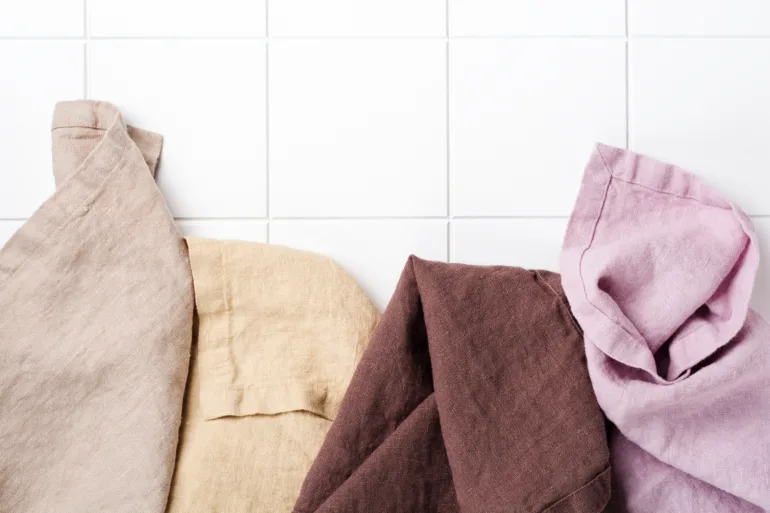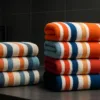Linen sheets are like the ultimate Parisian chic—they look effortlessly great, even if they look like they didn't even bother getting out of bed in the morning. But that timeless aesthetic requires proper care. Here's the full guide.
Linen sheets they are that piece of home luxury that we think of with the hope of sleeping like we're in a boho resort in the south of France. They are light, breathable, with that characteristic crinkly charm that makes our The bedroom is calling for a Pinterest post. But beware – linen, that sovereign ruler of natural fibers, requires a little more patience and gentleness than cotton. If not approached correctly, it can take its revenge with unpleasant stiffness, stubborn wrinkles and, oh yes, dramatic shrinkage.

But don't worry, flax is not a one-time thing - quite the opposite. With each treatment, it becomes softer, more pleasant and more durable. That's why we've prepared a detailed guide on how to properly wash, dry, and iron linen sheets so they stay in top shape for years, without having to decide between a natural look or an iron every time you wash them.
How often should we wash linen sheets?
For starters – linen sheets are not meant to be washed in the washing machine every other day. The ideal washing frequency is every 7 to 14 days, depending on your lifestyle. If you're one of those people who likes to take a deep shower before bed, washing every two weeks is probably enough. But if you sleep with makeup on, have pets, or have sensitive skin, you should wash weekly. Why? Because the sheets accumulate sweat, dead skin cells, makeup and debris from the outside world, which we wear to bed.
Washing linen more frequently will not harm it if you follow a few basic rules. On the contrary – linen becomes softer and more pleasant with every gentle care. But the word "gentle" here is not just a decoration; it is the foundation of the survival of your linen textile.

Washing preparation: linen is not cotton
First, forget everything you know about washing cotton sheets. Lan is a more demanding character. If you wash it in hot water, it will thank you by shrinking. If you use an aggressive detergent or a centrifuge, it can decide to break down the system.
Be sure to check the label before washing., as certain types of linen require the use of mild detergents for delicate fabrics. However, the golden rule applies: without softener. This creates a layer on the fibers that prevents the linen from breathing and softening through natural processes. If you still want some extra softness, use wool dryer balls, which also prevent the fabric from tangling during drying.
Linen sheets can be air dried, but expect them to feel a bit stiffer. For a blend of natural freshness and softness, use a tumble dryer on a low setting. low temperature and from it remove as soon as the cycle ends.
Washing linen sheets
When it's time to wash, separate light and dark items first. If you have several different linen items, wash them separately, as dark pigments can leave color and light fabrics quickly lose their delicate, natural color.
Before washing stains process locally – either with a gentle stain remover or a drop of dish detergent, which does a great job of removing cosmetics, oils, and other everyday invaders. Then wash the sheets on gentle cycle, in cold to lukewarm water. The dirtier they are, the more you may want to reach for lukewarm water, but don't overdo it.
Use the minimum amount of detergent – linen does not like a lot of foam or strong odors. If you have an organic detergent without additives, even better. After washing, immediately transfer them to the dryer or on a line – Waiting in the drum is the biggest enemy of smooth linen.
Drama-free drying
If you air dry your sheets, hang them on a flat surface or rope, preferably using wooden clothespins that do not leave marks. Linen will dry a little harder in the air, but will retain its characteristic structure. However, if you choose a dryer, set the temperature low and add wool dryer balls.
When drying is complete, fold immediately or – even better – stretch out on the bed again. This will avoid extra wrinkles, saving you the ironing step.

Ironing: only for the brave (or perfectionists)
It's true – linen sheets are naturally wrinkled. That's their look, their character, their fashion statement. But if you still want them to look like they came from a hotel catalog: no problem.
The best time to iron is when the sheets are still slightly damp. If they are already completely dry, you can lightly spray them with water from a spray bottle. Use iron on highest temperature with lots of steam (if it has a "linen" setting, even better) and iron in sections. Then hang up immediately, to dry completely without re-wrinkled. And please – if you have ironed them, do not fold them. It is similar to ironing a shirt and then stuffing it in a drawer.
Tips to keep sheets fresher longer
If you want to extend the time between washes (because let's face it, sometimes there really isn't time), follow these simple tips. This isn't science fiction, just... healthy sleep hygiene:
- Showering before bed is not a luxury, but an investment in freshness.
- Makeup belongs on the face, not on the sheets.
- Snacks should be left on the couch – the bed is not a bistro.
- If you have pets, treat them to their own blanket that you can wash more often.
Conclusion
Linen sheets They are not "low maintenance" - but they are highly rewarding. If you care for them properly, they will last you a long time, softening with each wash and creating that calming, aesthetic atmosphere. that we all want at the end of the day. And if someone says they're wrinkled? Tell them it's French design - and they'll be right.






